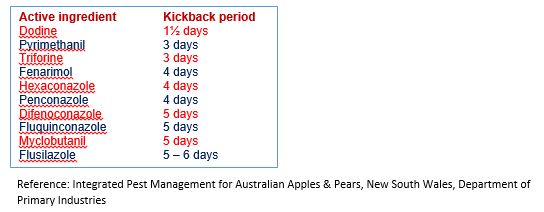A variety of fungicide sprays with differing modes of action are available for this diseases. When and how they are used depends upon their mode of action.
Protectant fungicides prevent the spores from germinating or penetrating leaf tissue and must be applied to the surface of susceptible tissue before infection occurs. These fungicides are applied routinely at 7 to 10 day intervals or according to anticipated infection periods.
Occurrence of infection can be predicted with an accurate weather forecast and the Mills table.
Curative fungicides control the Black Spot fungus inside leaves and fruit. These chemicals can penetrate plant tissues to eliminate or inhibit lesion development. The ability of these fungicides to stop infections is limited to a few hours, or up to few days (depending upon the specific fungicide), and often varies with temperatures during the first 24 to 48 hours after infection. Some fungicides can inhibit the fungus even later into the incubation period (the time between infection and the appearance of symptoms). Eradication of Black Spot lesions after they appear does not usually occur, but can be achieved with the proper rate and timing of certain fungicides.
The selection of fungicides for management of Black Spot is based on several factors, including the entire spectrum of other diseases that must be managed at that time, the potential for resistance in the Black Spot fungus to the selected chemical, the history of the disease in a particular orchard, the final market for the fruit and other social and economic factors. Good horticultural practices, such as proper site selection, tree spacing and annual pruning facilitates chemical control by improving spray coverage and reducing the length of wet periods.

Some of the fungicides used for control of apple and pear Black Spot have also effect on another important disease, powdery mildew. This disease is caused by fungi called Podosphaera leucotricha. Both fungi belong to the same group, Ascomycota and have very similar physiology. By using the fungicides which can control both diseases, costs of production can be significantly reduced. Besides spectrum of activity, other properties of pesticides must be taken into consideration such as resistance and cross-resistance properties, growth promotion or retardation, effect of beneficial organisms etc.
The entire cultivation program should be aimed at maintaining the trees’ natural resistance against diseases and pests so that no additional spraying is necessary. Trees with too much vigorous growth, for example, are especially susceptible to Black Spot, mildew, aphids, mites, and codling moths.
The goal of fertilization in integrated production is to cover the nutrient requirements through natural cycles. Soil analysis is the most important basis for the fertilizer dosage of phosphate, potassium, magnesium, boron and other nutrients.
Unbalanced fertilization and application of high rates of nitrogen fertilizers have also negative effect on vigorous growth and management of pests and diseases. It is necessary to apply the nitrogen during the phase of greatest demand and in the case of larger amounts, to distribute the amount over several applications. If the amount needed is more than 60 kg/ha, it must be allocated in multiple applications.
This approach in pest management is one of the basic principles of Integrated Pest Management – saves money, saves environment.
Products harmful to predatory mites should also be avoided. Treatments with dithiocarbamates must be reduced to a minimum and also the intervals between spraying with these products must be made longer.
When spraying with fungicides and miticides at the same time, the biological balance between pest and its natural enemies is disturbed. In this case, the use of dithiocarbamates, used for apple Black Spot control and other products harmful to beneficial insects, must be limited in order to guarantee the protection and promotion of predatory mites and other enemies of spider mites (spider beetles, minute pirate bugs, etc.). In orchards where selected pesticides are used, beneficial insects can live and thrive. The inconspicuous species (i.e. chalcid wasps) often escape our attention.
The goal of Integrated Pest Management is to guarantee the economic success of the orchard using as little and as environmentally-friendly plant protection products as possible.
References:
- Compendium of Apple and Pear Diseases, Published by the American Phytopathological Society
- Victoria State Government, Department of Economic Development, Jobs, Transport and Resources, Apple Scab
- UC Pest Management Guidelines, University of California, Statewide Integrated Pest Management Project.
- AGRIOS program for integrated fruit cultivation 2010, Italy




